Antique Bronze Sukhothai Walking Buddha Statues Temple Thai Amulet Wealth
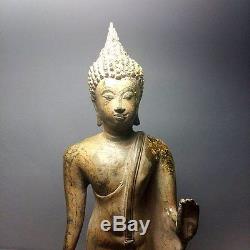
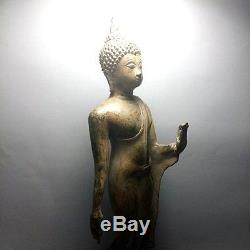
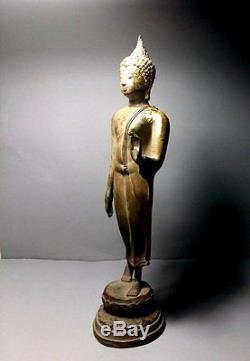
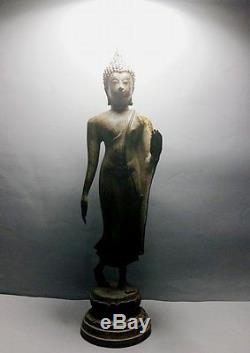
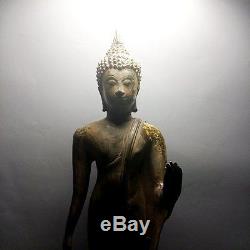
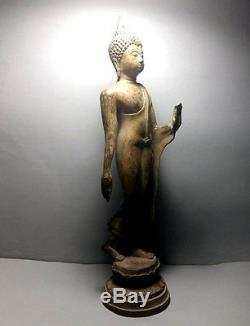
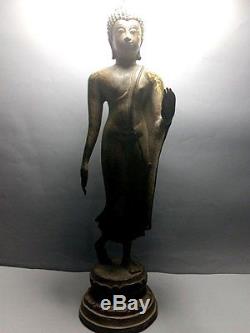
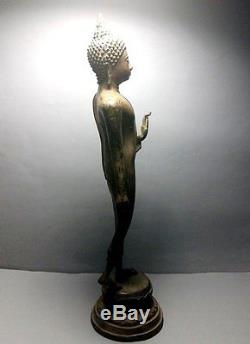
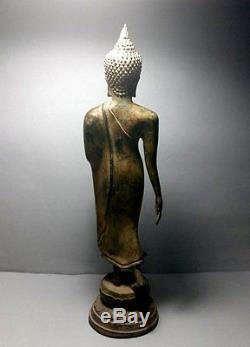
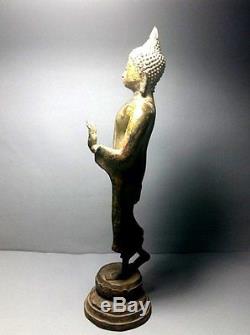
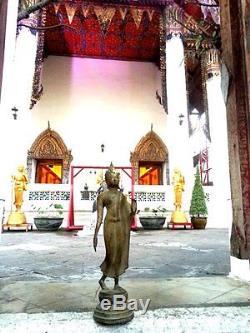
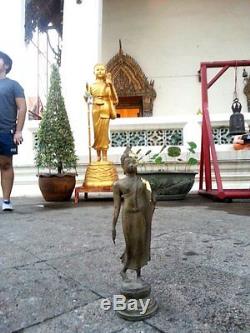

Antique Bronze Sukhothai Walking Buddha Statues Temple Thai Amulet Wealth. The Kingdom of Sukhothai had important contacts with Sri Lanka. Thai monks travelled to Sri Lanka for further religious instruction, and Sri Lankan monks settled in Sukhothai. Sukhothai religious art was thus influenced by Sri Lankan art. The Buddha images of the Sukhothai era gained important disdinguishing characteristics from the images during the Khmer and Mon era. A flame appeared on top of the head of the Buddha. The head is covered with fine curled hair. The face is oval, with high curving eyebrows, a hooked nose, a downward gaze, and overall displays a gentle smiling expression. The body of the Buddha images displays broad shoulders and a small waist. Overall it can be said that the Buddha Images do not appear human, but display idealistic or superhuman characteristics.
During the Sukhothai era, the four postures of the Buddha (sitting, standing, walking, reclining) were created. Buddha walking at Sukhothai Nation Park. Buddha images of the Sukhothai era are subdivided in several groups.
The image right below here displays Phra Phuttha Chinnarat image in Phitsanulok. It belongs to the Phra Phuttha Chinnarat group of images. Notice that the face is more rounded with a flame shaped aureole. The fingers on each hand are of equal lenght. Sitting Buddha images of the Sukhothai period most often display meditation posture, or the gesture of Subduing Mara. Walking Buddhas display the gesture of dispelling fear (Abhaya Mudra), or giving instruction (Vitarka Mudra). A magnificent and extremely rare 19th to 20th century bronze Sukhothai Buddha, from a temple precinct in the Sukhothai province of northern Thailand, beautifully rendered in an exalted profile, intricately carved with exacting detail. Temple blessed and consecrated, Buddha stands on a single Lotus bud with ornate pedestal.Rendition portrayed simple and elegant, with the elements of form and proportion conveying a sense of rhythmic motion, as if by mystical means levitating in meditation, walking with his right heel lifted and the left foot forward. The left arm is bent at the elbow with the hand raised in performing the Teaching gesture, the'Vitarka' mudra, formed by the thumb and forefinger joined in creating a circle. Typical of Sukhothai walking images the right arm is draped to his right side, appearing curved like that of an elephants trunk.
Buddha is modeled with dramatically curved contours, having well-defined broad shoulders, the chest inflated, and a narrow waist, wearing a long sanghati robe in the'Open Mode' worn diagonally over the left shoulder, leaving the right shoulder and breast uncovered, with the end fold draped to his mid-section, and marked with a fish-tail knotch. The undergarment is secured by the hint of a thin belt around the waist, with a central pleat draped in the front that desends down to the garments hem. The somewhat elongated head bears an ovoid shape, with shapely outlined curls of the head dip into the middle of the forehead to form a point, giving the face a heart shape.
The eyebrows curve like a bow, downcast eyes like lotus petals, and the nose pointed like a parrot's beak , a wide mouth with insipid smile, is framed by a second set of lips, recessed at the corners, and elongated earlobes stop short of the shoulders. The hair is knotted in shell-shaped spirals, surmounted by a hemispherical'Ushnisha', crowned with a tall flame-like Halo, representing the Buddha's spiritual energy. Bronze sculpture carved by an inspired, highly skilled Sukhothai artisan. The item "Antique Bronze Sukhothai Walking Buddha Statues Temple Thai Amulet Wealth" is in sale since Wednesday, December 06, 2017. This item is in the category "Antiques\Asian Antiques\Southeast Asia\Statues".
The seller is "theverybest99" and is located in default, SP. This item can be shipped worldwide.- Maker: Thai
- Type: Statues
- Primary Material: Bronze

